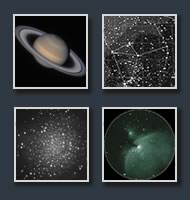Attaching a Cooling Fan to a Newtonian Telescope
The Thermal Problem
Cooling a reflector telescope is extremely important, especially if its fairly large (over 8"). As long as the primary mirror is warmer than the ambient temperature (and it usually is) several processes occur: Warm air rises from the mirror causing so called "tube currents", and a boundary layer of warm air forms near the surface of the primary mirror. The resulting turbulence degrades the wavefront, making the image "dance", and blurs its fine details. Also the mirror itself might change its properties if different parts of the mirror have different temperatures (a common cause for a spherical aberration).
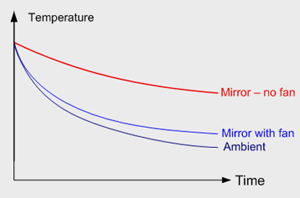
Mirror temperature with and without fan
Even if you take the telescope outside 1-2 hours before the observing session begins, a mirror will still be warmer than the ambient. That is because it takes longer for the glass mirror to cool down, than for air temperature to drop as the night progresses. This effect is especially severe in case of cold weather during winter and/or large mirrors. See an illustration which shows mirror temperature behavior (scale is arbitrary):
Active Cooling Options
The solution is active cooling of the primary mirror. There are several ways of doing the job, while most popular of them involve attaching some type of PC fan to back of the OTA (which is often fitted with screw holes for this purpose). There are many variations: An intake or an exhaust fan, one big or a several small ones. Additional option is to attach side fans, right over the mirror's surface. Each way have its advantages and disadvantages:
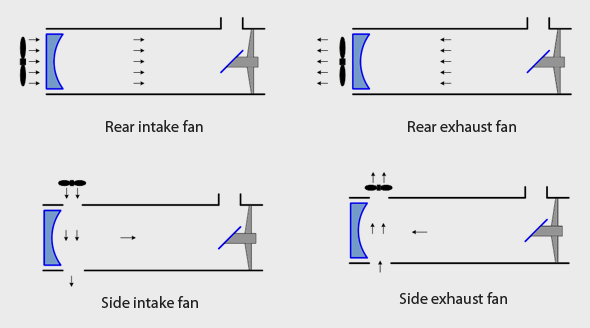
Reflector telescope active cooling methods and different fan placements
A large rear mounted intake fan, which blows the air on the mirror's surface, is the most effective for actually cooling the mirror. It might be a good idea to mount it on some sort of circular mask (preferably with a mesh dust filter), which will force the air into the OTA.
Exhaust rear fan is often used instead of an intake one because it doesn't suck up dust into the telescope from behind (which is closer to the ground), and arguably creates more laminar airflow inside the OTA, since the air enters the telescope from a clear aperture and not pushed by fan's blades from behind a mirror. Another reason for avoiding the intake method is that every fan slightly heats up the air flowing through it, especially if there is a dust filter.
Side mounted fans are used for blowing the hot turbulent boundary layer off the surface of the mirror. Usually these are small intake fans (with dust filters), probably to better direct the air stream and increase the "blow off" effect, and they are turned on during the whole observing session. Some experienced amateur astronomers claim that this is a must have modification for a serious planetary telescope. A clear disadvantage to this method is having to drill holes in the OTA. Note that for side blowing fans - smaller holes should be drilled on the opposite side, arranged in a line above the mirror edge, with the overall area comparable to the area of the fans.
A combination of rear and side fans can be used both for effective cool-down and for controlling the boundary layer.
There are more "exotic" methods - like suspending a small fan in front of the mirror, attaching a metal cooler or a peltier devices on the mirror's back end, or using a rear intake fan with a diaphragm around the main mirror (which forces the air to blow on mirror's surface).
While choosing the fan which is turned on during the observing - important consideration is the fan size and quality: A a quality "silent PC" type of fan from a known manufacturer (with ball or oil bearings) usually will do the job.
A large fan is capable of producing the same airflow as a small one, while working at lower RPM speed - Therefore theoretically it should produce less vibration. However in practice it not always true, since with one of my fans I found out that lower frequency vibrations of a large fan (a quality and expensive Noctua model) actually affect my telescope more then higher frequency vibrations of a smaller fan. Also not every "quiet" fan is necessarily vibration free. Therefore it's best to experiment with different models. In any case it's a good idea to have an option to limit the RPM speed by supplying a lower voltage (or adding a series resistor). Some "quiet" fans come built-in with such option.
Attaching the Fan - a Simple Example
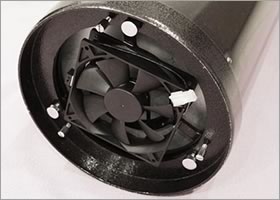
A fan attached to a 8" Newtonian telescope
For my 8" Orion Newtonian (and later for the 10" Skywatcher as well) I've simply attached a large rear fan directly to the mirror cell. I've used an Antec 3 speed 120mm fan, which have proven to be vibration free and has a very handy 3 speed option. I did the attachment the simplest way possible - using a thick double sided "Scotch" adhesive tape. It is the same tape I use to attach my secondary mirror.
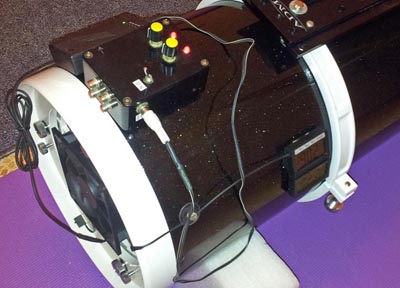
A cooling fan, a dew controller , a Li-ion battery and mirror/ambient thermometer mounted on a 10" Newtonian telescope
In my 10" Newtonian in order to avoid routing the power to the telescope from an external battery - I've attached, using a velcro tape, a power source to the telescope's body as well. It is a small Li-Ion battery which powers the cooling fan and a dew controller box.
Probably a better (and a more complex) way would be to use some sort of dampening rubber to fight the vibrations. However in my case I found out that at low speed settings the vibrations are negligible, and I couldn't notice any effect from them even during planetary astrophotography. At maximum speed on a 8" telescope - the vibrations did blur the stars into long streaks, but I only use this speed for the initial cool-down.
It is curious that an attempt to mount the fan using an external "cap" to the telescope's body, which was supposed to improve the airflow efficiency, actually caused really bad vibrations to my 10" scope, as opposed to attaching the fan directly to the mirror cell. Maybe this introduced some sort of resonance specific for my setup and the fan speed, or maybe the mirror cell's springs act as a dumpener. Note that it my latest 12" Orion UK Newtonian the factory mounted small fan is also integrated into the mirror cell, and it's not causing noticeable vibrations.

A dual display thermometer
Note: nowadays it's very cheap to buy an electronic thermometer with an external sensor which is supposed to show "inside" and "outside" temperature. I've attached such device to my telescope, with its "outside" sensor fixed to the back surface of the mirror (you can see it in a previous picture). This way I can easily know when my telescope is ready for the observing session.

